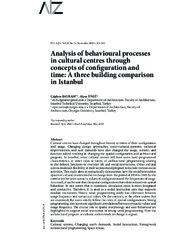Analysis of behavioural processes in cultural centres through concepts of configuration and time: A three building comparison in Istanbul
| dc.contributor.author | Bayram, Ç. | |
| dc.contributor.author | Ünlü, Alper | |
| dc.date.accessioned | 2024-02-16T06:12:23Z | |
| dc.date.available | 2024-02-16T06:12:23Z | |
| dc.date.issued | 2023 | |
| dc.identifier.issn | 2564-7474 | en_US |
| dc.identifier.uri | http://hdl.handle.net/10679/9154 | |
| dc.identifier.uri | https://www.az.itu.edu.tr/index.php/jfa/about | |
| dc.description.abstract | Cultural centres have changed throughout history in terms of their configuration and usage. Changing design approaches, socio-cultural patterns, technical improvements, and user demands have also changed the usage, content, and function added resulting in changing the spatial configuration and architectural program. In Istanbul, some cultural centres still have some hard-programmed characteristics or strict rules in terms of architectural programming relating to the defined functions in everyday life and social interactions. Other cultural centres maintain flexibility in their architectural program to include various social activities. This study aims to syntactically demonstrate how the social interaction spaces of cultural centres tended to change from the period of 1938 to 2005 by the correlation between syntactic values of configuration and the frequencies of usage. As a result, it can be seen that the spatial configurations have determinants on spatial behaviour. In one centre that is examined, circulation space is more integrated and connective. Therefore, it is used as a social interaction area that supports random encounters. Hence, weak programming rarely has coherence between usage frequency and syntactical values. On the contrary, in the other centres that are examined, the users strictly follow the rules of spatial configurations. Strong programming also has more significant correlations between syntactic values and usage frequency. The crucial role of spatial morphology and user behaviour are highlighted to support social interaction in strong-weak programming. How the architectural program in cultural centres tends to change is argued. | en_US |
| dc.language.iso | eng | en_US |
| dc.publisher | Istanbul Teknik Universitesi | en_US |
| dc.relation.ispartof | A/Z ITU Journal of the Faculty of Architecture | |
| dc.rights | openAccess | |
| dc.title | Analysis of behavioural processes in cultural centres through concepts of configuration and time: A three building comparison in Istanbul | en_US |
| dc.type | Article | en_US |
| dc.description.version | Publisher version | en_US |
| dc.peerreviewed | yes | en_US |
| dc.publicationstatus | Published | en_US |
| dc.contributor.department | Özyeğin University | |
| dc.contributor.authorID | (ORCID 0000-0002-6134-4726 & YÖK ID 13117) Ünlü, Alper | |
| dc.contributor.ozuauthor | Ünlü, Alper | |
| dc.identifier.volume | 20 | en_US |
| dc.identifier.issue | 3 | en_US |
| dc.identifier.startpage | 515 | en_US |
| dc.identifier.endpage | 531 | en_US |
| dc.identifier.doi | 10.58278/0.2023.19 | en_US |
| dc.subject.keywords | Changing user’s demands | en_US |
| dc.subject.keywords | Cultural centres | en_US |
| dc.subject.keywords | Social interaction | en_US |
| dc.subject.keywords | Space syntax | en_US |
| dc.subject.keywords | Strong/weak architectural programming | en_US |
| dc.identifier.scopus | SCOPUS:2-s2.0-85177818767 | |
| dc.relation.publicationcategory | Article - International Refereed Journal - Institutional Academic Staff |
Files in this item
This item appears in the following Collection(s)
Share this page



